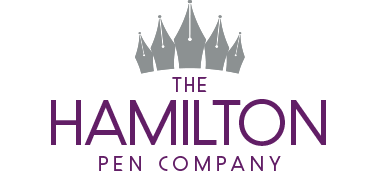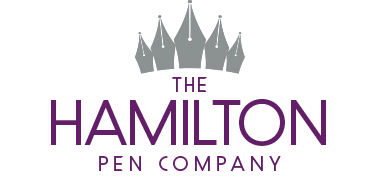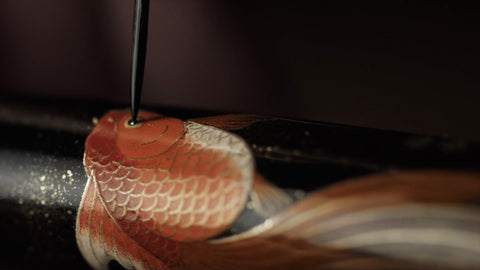Urushi Lacquer Pens - When History and Modernity Collide
Maki-e & Urushi Lacquer Pens at The Hamilton Pen Company
Not so long ago we received the Namiki Emperor 2022 Limited Edition Fountain Pen at Hamilton Pens HQ and found it to be absolutely mesmerising. The level of detail, the various textures, the 360 degree design…absolutely everything about this pen is impeccable and it got me thinking about the craftsmanship that goes into creating a work of art such as this.
The 2022 limited edition from the Namiki Emperor range is connected to its historical roots through some of the elements such as the No. 50 size 18ct gold nib which is the same size as Maki-e pens pen 100 years ago, the primary adornment of this pen is created using the Togidashi-Taka Maki-e technique which is a burnished-raised Maki-e and one of the most highly skilled embodiments of the ancient art form. Each Elephant pen is handcrafted and takes several months to complete with the Elephant itself depicted in Shishiai Togidashi-Taka Maki-e and Raden (whereby lustrous shellfish is embedded or pasted in the lacquer - but more on that later) giving a beautifully tactile experience akin to experiencing the strength and texture of the actual elephants skin! Remarkably beautiful - no doubt - but also steeped in meaning and symbolism, the Namiki Emperor 2022 Limited Edition is an absolute triumph.
More than just an attractive pen, it is a fine example of traditional Japanese lacquering techniques. Entire volumes could be written on the subject but here we dip our toe into the world of Urushi and Maki-e pen lacquering techniques.
What is Urushi Lacquer?
Dating back as far as Japan’s Jomon period (6000 BCE - 300 BCE), Urushi has been used as ornamentation, a coating and also as an adhesive to bind the grips of axe handles. With its natural preservative and antiseptic properties, Urushi was also used to protect valuables such as musical instruments, furniture and jewellery from excessive wear and tear. Ultimately, Urushi became highly valued for its aesthetic appeal and became a prominent element in many works of art.

The lacquer is a natural glaze from the sap of the Rhus Verniciflua tree with incredible properties of adhesion and resistance unlike other enamels and paints. Discovered between 5000 and 9000 years ago (I have found a variety of dates within my research). The lacquer tree is a relative of poison ivy and can only be found in southern China, Korea, Vietnam and Japan - all of which call the lacquer Urushi. Urushi is considered a precious material now, with only 150g of sap able to be collected from each mature lacquer tree over 10 years old at a time! Only 1.5 tons of Japanese Urushi can be harvested annually.

Image Credit: https://www.rest-art.biz/2020/02/19/lacca-urushi-2/
The majority of Urushi lacquer used in Japan is of chinese origin and shipped to Japan for processing because Chinese Urushi costs just 10% of Japanese Urushi. Slight compromises and adjustments to techniques are required because Chinese Urushi is not as transparent or liquid as Japanese Urushi. Irrespective of its origin, Urushi Lacquer is unquestionably tough and robust. Nitrohydrochloric Acid (a chemical which melts gold) can not erode the lacquer and it has a hardness of 6 on the Mohs Scale - this is about the same as glass or a stone.
Unlike other lacquers, Urushi does not air dry in the way one might expect. Drying chambers are used with warm moist conditions created with a temperature ranging between 25 and 28 degrees and humidity levels of 65 to 80%.
Urushi is now synonymous with delicate art forms, the beginnings of Urushi lacquering are more humble as the stone age in East Asia utilised Urushi to coat items such as baskets, wood and pottery. It grew to prominence when it began to be used more widely to create religious imagery of Buddha, to decorate plates and utensils for traditional cuisines and tea ceremonies and even it found its uses in the creation of armour.

An Example of Maki-E Raden - Image Credit: ColBase: 国立博物館所蔵品統合検索システム (Integrated Collections Database of the National Museums, Japan), CC BY 4.0 <https://creativecommons.org/licenses/by/4.0>, via Wikimedia Commons
The charm of Maki-e and Urushi Lacquering eventually spread to Europe and began to garner the interest of the West but Japan was very much cut off from the West until the 19th Century so this process was perhaps somewhat stunted. The 21st century growth of social media has certainly aided the resurgence in interest.
What is Maki-e Pen Lacquering?
Maki-e is the Japanese Lacquer decoration technique which is translated to literally ‘splashed picture/drawing’. The Maki-e technique takes the natural glaze ‘lacquer’ and uses it to draw, create patterns or add lettering to the surface of objects. For the purposes of our discussion we are referring to this process as a design technique for writing instruments - specifically pens.

Image Credit: www.pilot-namiki.com
The lacquer is applied layer by layer, meticulously over months and the more lacquer is applied, the deeper the colour becomes and the elements of the design begin to pop. There are four main processes that take place; lacquering, drawing, sprinkling and polishing. Each is completed in turn then repeated many many times over, some maki-e fountain pens require the four stages to be completed as many as 130 times before a design is complete! This incredible level of skill and dedication is part of the charm and one of many reasons why Maki-e and Urushi pens are experiencing a resurgence in popularity for the modern collector.
The Techniques of Maki-e
There are several types of Maki-e techniques that are commonly noted, each holds similarities in their technique yet each has individual aspects unique to one another, they include;
Hira Maki-e
Otherwise known as flat Maki-e, Hira Maki-e decorates the lacquered main design with sprinkled gold and/or silver powders before additional lacquer is applied. Once hardened, the full impact of the design is revealed by burnishing the lacquer.
Although the simplest of the maki-e techniques, Hira Maki-e was developed in the latter half of the Heian period (794 AD-1185 AD) after togidashi maki-e and completed in the Kamakura period (1185 AD - 1333 AD) because it was necessary to make the particles of metal powder finer. This technique was popular in the Azuchi-Momoyama period (1568 AD - 1600 AD), when mass production of maki-e was necessary.
Togidashi Maki-e
Otherwise known as burnished Maki-e, the main design is created using Hira (flat) Maki-e techniques followed by fully covering the entire body of the pen with Urushi lacquer. The design is then revealed by burnishing the lacquer with charcoal.
Raden
One of the most striking forms of Japanese Lacquering and one that appears to be growing in popularity quickest in the resurgence of these amazing pens, Raden uses shell cut seemingly impossibly small and laid to create designs secured in place by Urushi lacquer. The design is then burnished to create a striking finish with the pearlescence of the shell almost glowing against the richness of the lacquer.
Hyoumon
This method utilises foiling to create the design. Sheets of gold or silver are cut into designs and embedded into the lacquered surface and coated by further layers of lacquer to secure the metal foils in place. As with many other techniques, the urushi lacquer layer is burnished with charcoal to reveal the design embedded in the layers below.
Rankaku
Similarly to Raden, this technique takes natural elements and places them within the lacquer layers of the design work on the pen to create the final scene. However, Raden uses shell and Rankaku makes use of small pieces or powdered eggshell (often quail) to create the desired effect.
Chinkin
This technique requires the use of specialist chisels to engrave a pattern onto the lacquered surface. This engraving is then inlaid with gold leaf or gold powder and an additional layer of lacquer to seal in the design.
Togidashi-Taka Maki-e
This burnished and raised Maki-e places greater emphasis on the main design through the use of lacquer and charcoal powder once a background and other elements are completed. The key design is then completed using the same techniques as Hira (flat) Maki-e resulting in an opulent and dramatic finish.
Togidashi-Hira Maki-e
The main design is created using Hira (flat) Maki-e techniques once the full scene has been completed using Togidashi Maki-e methods.
Shishiai Togidashi Maki-e
This is a combination of raised and burnished Maki-e and requires really advanced techniques. The technique requires that Urushi Lacquer and Charcoal are built up to bring the design into relief, the design is then smoothed to a gradient and burnished to create a uniform lustre and shine.
Urushi and Maki-e Pens at The Hamilton Pen Company
At the point of writing, there are four main Maki-e/Urushi pens available at the Hamilton Pen Company. The first, having already been mentioned, is the exquisite...
Namiki Emperor 2022 Limited Edition Fountain Pen - Elephant

The Namiki 2022 Limited Edition pen is limited to just 99 pieces worldwide and the exceptional artwork featured on this fountain pen was designed by Mamoru Wakabayashi of the highly revered Kokkokai group. Each handcrafted Elephant pen takes many months to complete.
The African elephant is the largest land animal and has an extraordinarily long life. Intelligent, wise and fiercely loyal, it symbolises prosperity and life. When a baby elephant is born, it is immediately protected by the entire herd, which teaches it to live with its family as a human would.
The soft scene of a sunset over the savannah created on the feather cap transports us to Africa. The elephant is depicted in Shishiai Togidashi-Taka Maki-e and Raden, allowing us to feel the strength and texture of the elephant's skin.

An egret completes the scene, to highlight the symbolic relationship of the two animals throughout their lives. The egret cares for the elephant's skin and the elephant protects it from predators.
A unique and poetic setting, with extravagant colours, that pays homage to the cradle of humanity and to the nature to be protected. The artist wanted to raise awareness here, painting this majestic animal, threatened with extinction by humans. Protecting our environment, its fauna and flora, to survive tomorrow.
The pen comes with an 18ct gold nib engraved with the effigy of Mount Fuji in either Medium or Broad sizes and has an eye dropper filling system. Presented in an elegant wooden casket with a bottle of Black Namiki ink and certificate of authenticity.
Pilot Custom 845 Urushi Fountain Pen - Red

The Pilot Custom 845 has an ebonite body that is adorned with the fabulous and exceptional Urushi lacquer, a highly prized material that has been refined for over 7000 years!
Available in a red and black version, the black finish underlines the ends of its vermilion body and cap. The top of the cap is surmounted by a gold-plated patch and then by a grooved ring under which is inserted its engraved PILOT clip, identical to that of Namiki’s.
The lower end of the body has a grooved ring and its two-tone engraved 18ct gold nib highlights its elegant look.
Namiki Yukari 2021 Limited Edition Fountain Pen - Tanuki
The Namiki Yukari Tanuki fountain pen is made using Hira & Togidashi Maki-e techniques, and contains gold powder to give great elegance to this piece of art.

The Tanuki is a pretty little vixen dog that we frequently find in the form of auspicious figurines at the entrance of the shops in the land of the rising sun. If you write its name in phonetic characters, it means “surpassing others” and remains a symbol of commercial prosperity. It is often characterised by 8 attributes, called the "8 blessings":
• The straw hat against evil,
• The eyes to recognize a customer’s potential,
• The happy face with the indispensable smile in the business world,
• The rounded belly that evokes safety,
• The sake vial that recalls moderation in behaviour,
•The general ledger to balance revenues and expenditures,
• The thick tail that symbolizes stability,
• The bag of gold coins for prosperity...
This magnificent Yukari fountain pen will bring happiness and success to its purchasers in this special period.
The pen is limited to 300 pieces world-wide and is signed by KOKKOKAI group’s artisans.
The pen comes with an 18ct gold nib and uses cartridges or an ink converter (supplied).
Namiki Capless Raden Fountain Pen - Stripes




